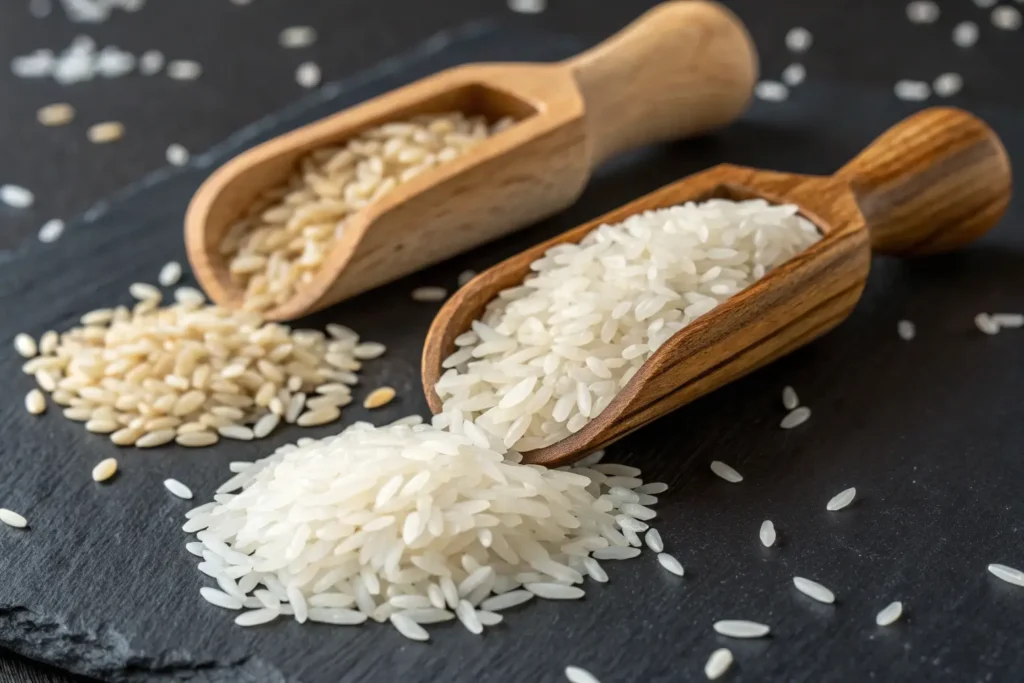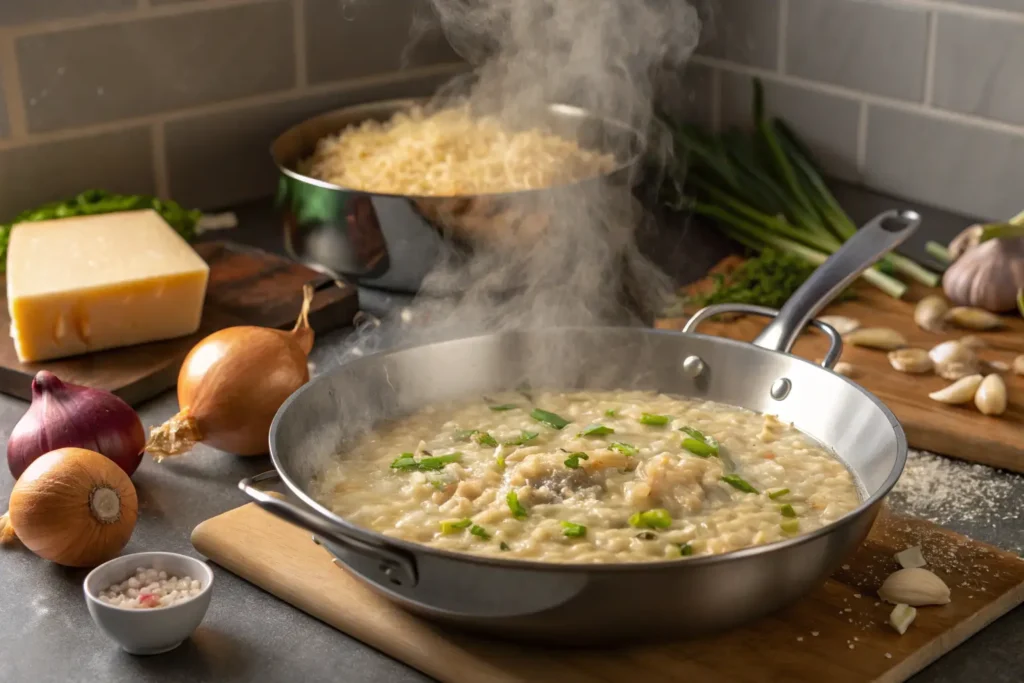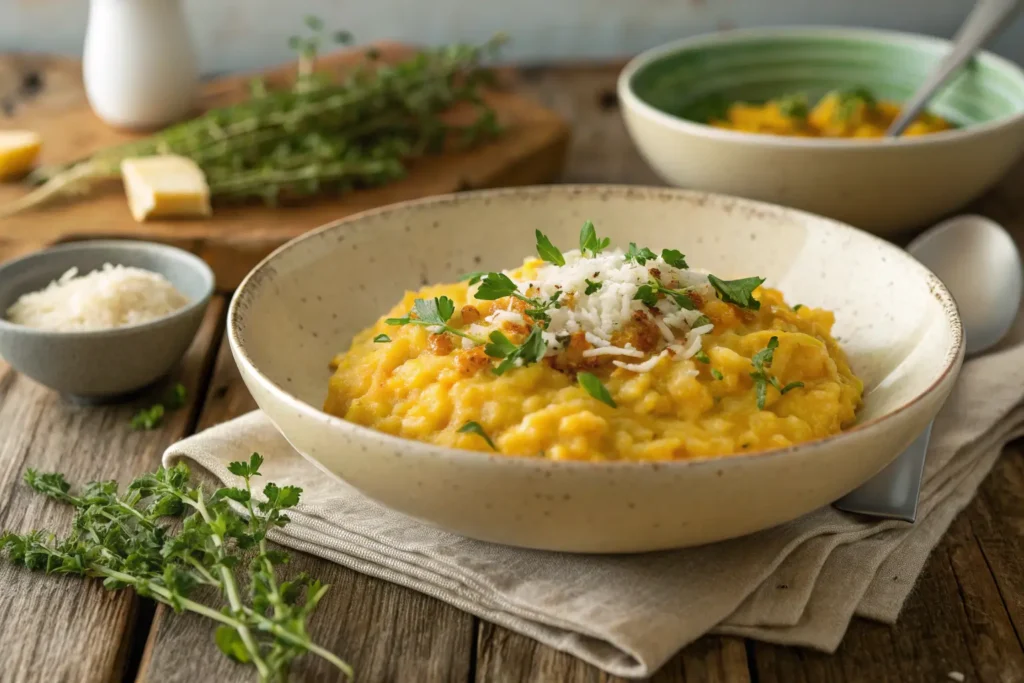Introduction
Rice is a staple food enjoyed in countless forms worldwide, from fluffy white basmati to sticky sushi rice. But when it comes to risotto, the conversation shifts from simplicity to culinary finesse. The term risotto often stirs curiosity, especially among food enthusiasts and novice cooks alike. Is risotto just another type of rice? Or is there something inherently unique about it?
In this article, we’ll dive deep into the world of risotto and rice, unraveling their differences, cooking methods, and the reasons behind risotto’s signature creamy texture. Along the way, we’ll explore common misconceptions, substitutions, and tips for mastering a risotto dish. Let’s uncover the secrets of this beloved dish, starting with the basics.
Introduction to Risotto and Rice
What is rice?
Rice is one of the most widely consumed grains on Earth. With over 40,000 varieties available, this versatile crop ranges from long-grain options like jasmine and basmati to short-grain types such as sushi rice. It’s a kitchen chameleon, easily adapting to numerous cuisines and cooking techniques, including steaming, boiling, and frying. Rice’s simple, neutral flavor makes it a staple ingredient, but not all rice is created equal.
What is risotto?
Risotto, on the other hand, is not a type of rice—it’s a method of cooking. Originating in northern Italy, risotto transforms specific short-grain rice varieties, such as Arborio or Carnaroli, into a creamy, luxurious dish. These rice types are rich in starch, which is essential for creating the signature texture of risotto. Unlike plain boiled rice, risotto requires careful attention and gradual stock absorption, yielding a dish that’s as much about technique as it is about flavor.
How are they commonly confused?
Many assume risotto is simply a different type of rice due to its distinct texture. However, the creamy consistency of risotto isn’t inherent to the grain itself but comes from the slow cooking process and the unique starch properties of the rice used. This confusion often leads people to believe risotto is interchangeable with other rice varieties, but as we’ll explore, it’s not that simple.
Key Differences Between Risotto and Regular Rice
Types of Rice Used in Risotto
One of the most significant distinctions between risotto and regular rice lies in the type of rice used. Risotto demands specific short-grain varieties like Arborio, Carnaroli, or Vialone Nano. These rice types are packed with amylopectin, a starch that contributes to risotto’s creamy texture. On the other hand, common rice varieties like basmati or jasmine lack the starch content necessary for this luxurious consistency.
For example, Arborio rice is widely favored due to its ability to absorb liquid without becoming mushy. This unique quality makes it the go-to choice for risotto recipes, such as those featured in this easy risotto guide. By contrast, regular rice varieties are often cooked with the goal of producing light, fluffy grains that remain separate.

Texture and Preparation Differences
The difference between risotto and regular rice goes beyond the grains themselves. Traditional rice preparation, such as steaming or boiling, focuses on simplicity and efficiency. Risotto, however, involves a more intricate cooking process. It requires constant stirring and gradual addition of warm stock, allowing the starch to release and create the dish’s signature creaminess.
Regular rice is typically cooked in water and then drained, resulting in a firm and dry texture. Risotto’s texture, by comparison, is creamy and cohesive, providing a comforting, indulgent dining experience.
The Role of Starch in Creating Risotto’s Creamy Texture
What sets risotto apart is the role of starch. As you slowly cook and stir risotto rice, the starch granules break down, thickening the cooking liquid into a velvety sauce. This process cannot be replicated with rice varieties like jasmine or long-grain white rice, which lack the necessary starch levels.
Moreover, the addition of ingredients like butter, wine, and Parmesan cheese further elevates risotto’s richness, making it a sought-after dish in fine dining. This difference highlights why the question Is risotto different from rice? often comes up, as the creamy consistency is unmatched by regular rice dishes.
Understanding the Cooking Methods
Risotto as a Technique, Not Just a Dish
Risotto isn’t merely a type of rice; it’s a cooking method. Originating in Italy, the technique emphasizes slowly building layers of flavor while coaxing out starch from the rice. In contrast, traditional rice cooking focuses on minimizing effort and time.
The risotto method starts with toasting the rice in fat, typically olive oil or butter. Next, a splash of white wine is added for deglazing, imparting acidity that balances the dish. The rice is then cooked in increments of warm stock, which is absorbed gradually as you stir. This unique process transforms the rice into a creamy masterpiece.
Comparison with Other Rice Cooking Methods
Unlike risotto, rice pilaf or steamed rice aims for separate, fluffy grains. For instance, pilaf involves sautéing rice with aromatics before simmering it in a measured amount of liquid, which is absorbed entirely during cooking. Steaming, on the other hand, eliminates the need for stirring and results in a simple, light texture.
Risotto’s labor-intensive approach sets it apart. Constant stirring may sound daunting, but it’s essential for achieving the dish’s smooth consistency. While regular rice preparation prioritizes convenience, risotto rewards patience with flavor and texture.
Essential Steps in Cooking Risotto
Cooking risotto involves several critical steps. First, the rice is toasted to enhance its nutty flavor. Then, it’s deglazed with wine, which lifts any browned bits from the pan and adds depth. Finally, the rice is slowly cooked with stock, stirred consistently to release starch, and finished with butter and cheese for extra richness.
While time-consuming, these steps ensure the rice absorbs flavors beautifully. Mastering this technique answers th
e question, Is risotto different from rice? with a resounding yes—it’s a meticulous process that turns simple ingredients into something extraordinary.
Culinary Uses and Pairings
Dishes Commonly Made with Risotto Rice
Risotto rice is the foundation of many delectable dishes that go beyond the classic Italian preparation. From creamy mushroom risotto to seafood-packed versions like shrimp or scallop risotto, the versatility of this dish is truly impressive. While regular rice often takes a backseat as a side, risotto shines as the star of the plate.
Another popular use of risotto rice is in dishes like arancini, which are fried rice balls often stuffed with cheese or meat. These golden bites showcase risotto’s ability to hold its shape while maintaining its creamy interior.
If you’re interested in preparing your own risotto-based dish, check out this easy risotto guide for detailed steps and creative variations.
Flavor Profiles and Ingredient Pairings
Risotto’s creamy texture and mild flavor make it a blank canvas for a variety of ingredients. Earthy mushrooms, sweet peas, or fresh asparagus pair beautifully with the dish. For seafood lovers, prawns, scallops, or clams enhance risotto’s luxurious feel.
Herbs like thyme, parsley, and chives add fresh notes, while a drizzle of truffle oil or a sprinkle of Parmesan cheese elevates the dish further. These pairings highlight why risotto is a preferred choice for elegant dining and special occasions.
Why Risotto Is Considered Luxurious in Certain Cuisines
Risotto has earned its reputation as a luxurious dish due to its rich taste, creamy texture, and labor-intensive preparation. Unlike regular rice, which is simple and quick to cook, risotto requires attention and care. The slow cooking process not only enhances the dish’s texture but also creates a depth of flavor that is unmatched.
Common Misconceptions and Substitutions
Is Sushi Rice the Same as Risotto Rice?
A common misconception is that sushi rice can substitute for risotto rice because they both have short grains. While sushi rice shares a similar starch content, it doesn’t behave the same way during cooking. Sushi rice is designed to be sticky, not creamy, so it won’t achieve the velvety texture of a classic risotto.
This question often arises when people wonder, Is risotto different from rice? The answer lies in the specific properties of risotto rice varieties like Arborio, which are ideal for gradual liquid absorption and starch release.
Can You Make Risotto with Other Types of Rice?
Yes, but with limitations. Brown rice, for instance, can be used to make risotto, though the texture and flavor will differ significantly. The cooking time for brown rice is longer, and its outer bran can hinder the creamy consistency that defines risotto.
For those without access to traditional risotto rice, options like pearled barley or farro can mimic some of the creamy texture, though the flavor and structure will vary. It’s worth experimenting to find what works best for your palate and pantry.
Misconceptions About Risotto Being Difficult to Prepare
Many believe risotto is too complicated for home cooks, but this isn’t entirely true. While it does require attention and patience, risotto is forgiving. The key is to stay attentive, add liquid gradually, and taste frequently. Mastering these steps demystifies the process and makes risotto an approachable dish.
For more tips and tricks to perfect your risotto, explore other helpful guides and recipes on My Tested Recipes.
How to Perfect a Risotto Dish
Tips for Achieving the Perfect Texture
Perfecting risotto is an art, but it’s not as intimidating as it seems. One of the most crucial tips is to use warm stock. Cold liquid can shock the rice and disrupt the cooking process, resulting in unevenly cooked grains. Keep your stock on a low simmer to ensure smooth absorption.
Next, choose the right rice. Arborio, Carnaroli, or Vialone Nano are your best bets, as their high starch content creates the dish’s signature creaminess. Stir frequently but not obsessively—this helps release the starch while preventing the rice from sticking to the pan.
Don’t rush the process. Risotto thrives on patience. Gradually add the stock in small increments, allowing the rice to absorb the liquid fully before adding more. This step is key to achieving the creamy consistency that makes risotto so special.

Common Mistakes to Avoid
One common mistake is overcooking the rice. Risotto should have a slight bite, known as al dente, rather than being mushy. Tasting as you go ensures the texture is just right.
Another pitfall is skipping the toasting step. Toasting the rice in butter or olive oil before adding liquid enhances its nutty flavor and ensures the grains stay firm.
Finally, don’t underestimate the importance of finishing touches. Stir in a pat of butter and a generous handful of Parmesan cheese for added richness. These small details can elevate your risotto from good to great.
Why Using the Right Stock Is Essential
Stock is the backbone of any risotto. Whether you’re using chicken, vegetable, or seafood stock, the quality of the liquid directly impacts the final dish. Homemade stock is ideal, as it adds depth and flavor. If you’re using store-bought stock, opt for low-sodium versions to control the salt levels in your risotto.
FAQs About Risotto and Rice
What Is the Difference Between Arborio and Carnaroli Rice?
Arborio rice is the most common choice for risotto, but Carnaroli is often considered superior. Carnaroli has a higher starch content, making it creamier and more forgiving during cooking. It also holds its shape better, which is why many chefs prefer it for risotto.
Can Risotto Be Made Ahead of Time?
Technically, yes, but it’s best enjoyed fresh. If you need to make it in advance, cook it until it’s slightly underdone, then cool it quickly. When ready to serve, reheat it with a bit of stock to restore the creamy texture.
Why Does Risotto Take Longer to Cook Than Regular Rice?
Risotto takes longer because it’s cooked slowly, with liquid added incrementally. This method allows the rice to release its starch gradually, creating the creamy texture that sets risotto apart from regular rice dishes.
Is Risotto Gluten-Free?
Yes, risotto itself is gluten-free, as it’s made from rice. However, be cautious of added ingredients like broth or pre-packaged mixes, which may contain gluten. Always check labels to be sure.
Cultural Significance of Risotto and Rice
The Role of Risotto in Italian Cuisine
In Italy, risotto is much more than just a dish; it’s a symbol of regional pride and culinary artistry. Northern Italy, particularly Lombardy and Piedmont, is the birthplace of this creamy delight. Unlike pasta, which dominates southern cuisine, risotto reflects the rice-growing traditions of the north.
Each region has its own signature risotto. For instance, Milan is famous for Risotto alla Milanese, a golden-hued dish flavored with saffron. Meanwhile, Venice offers Risi e Bisi, a springtime favorite made with fresh peas. This cultural diversity showcases why risotto holds a special place in Italian kitchens.
How Rice Differs in Global Cuisines
While risotto epitomizes Italian cooking, rice plays an equally vital role in cuisines worldwide. In Asia, rice is a staple food, often steamed and paired with bold flavors. In Spain, it takes center stage in paella, while in the Middle East, rice is featured in aromatic pilafs.
This global perspective often leads to the question, Is risotto different from rice? The answer lies in how it’s prepared and celebrated. Risotto is a testament to Italian craftsmanship, while rice in other cuisines emphasizes simplicity and adaptability.
Final Thoughts on Risotto vs. Rice
Why Understanding the Difference Matters
The distinction between risotto and rice might seem subtle at first, but it speaks volumes about culinary traditions and techniques. Risotto transforms rice into a luxurious dish through a slow, deliberate process. Understanding this method helps us appreciate the care and precision that goes into making it.
Moreover, knowing the difference allows you to make informed choices in the kitchen. Whether you’re preparing a quick bowl of steamed rice or indulging in a creamy risotto, each method brings its unique charm to the table.
Is Risotto Different from Rice? A Resounding Yes
So, is risotto different from rice? Absolutely. Risotto isn’t just about the grain—it’s about the process. The constant stirring, gradual liquid absorption, and rich finishing touches create a dish that’s far removed from a simple pot of boiled rice.
The next time you sit down to enjoy a steaming bowl of risotto, take a moment to savor the care and tradition behind every bite. For more tips and recipes to elevate your cooking, check out helpful resources like this risotto guide.

